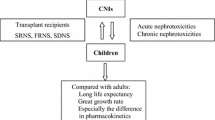Abstract
Background: Calcineurin inhibitors (CNI) are the main immunosuppressive drugs in solid organ transplantation. However, their use is hampered by side effects like nephrotoxicity. We report an exceptional experience with three children treated with sirolimus after combined liver and kidney transplantation with prolonged renal failure and CNI-associated nephrotoxicity. Patients and results: Two girls experienced prolonged renal graft failure after combined liver-kidney transplantation for 11 and 12 weeks. Repeated biopsies did not show any rejection but did exhibit tubular damage and acute CNI-toxicity. A boy with hyperoxaluria after liver and (a third) renal transplantation experienced acute renal graft failure after an early steroid-resistant rejection. All children were switched to sirolimus-based immunosuppression and cessation of CNI therapy, which was followed by rapid improvement of renal function. Rejection of liver or kidney did not occur after CNI withdrawal. Sirolimus was commenced with 3 mg/m2/day in two doses and resulted in reasonable drug exposure. However, drug monitoring was required to adjust sirolimus dosage. Summary: Prolonged renal failure after transplantation with severe CNI toxicity may be salvaged successfully with sirolimus-based immunosuppression.

Similar content being viewed by others
References
Seikaly M, Ho PL, Emmett L, Tejani A (2001) The 12th Annual Report of the North American Pediatric Renal Transplant Cooperative Study: renal transplantation from 1987 through 1998. Pediatr Transplant 5:215–231
Burdmann EA, Andoh TF, Yu L, Bennett WM (2003) Cyclosporine nephrotoxicity. Semin Nephrol 23:465–476
Chung J, Kuo CJ, Crabtree GR, Blenis J (1992) Rapamycin-FKBP specifically blocks growth-dependent activation of and signaling by the 70kd s6 protein kinases. Cell 69:1227–1236
Kahan BD (for the Rapamune US Study Group)(2000) Efficacy of sirolimus compared to azathioprin for reduction of acute renal allograft rejection: a randomized multicentre study. Lancet 356:194–202
McAlister VC Gao Z, Peltekian K, Domingues J, Mahalati K, MacDonald AS (2000). Sirolimus-tacrolimus combination immunosuppression. Lancet 355:376–377
Flechner SM, Galdfarb D, Modlin C, Feng J, Krishnamurthi V, Mastroianni B, Savas K, Cook DJ, Novick AC (2002) Kidney transplantation without calcineurin inhibitor drugs: a prospective, randomized trial of sirolimus versus cyclosporine. Transplantation 74:1070–1076
Trotter JF (2003) Sirolimus in liver transplantation. Transplant Proc 35(Suppl):S193–S200
Kreis H, Oberbauer R, Campistol JM, Mathew T, Daloze P, Schena FP, Burke JT, Brault Y, Gioud-Paquet M, Scarola JA, Neylan JF (for the Rapamune Maintenance Regimen Trial)(2004) Long-term benefit with sirolimus-based therapy after early cyclosporine withdrawal. J Am Soc Nephrol 15:809–817
Egidi MF, Cowan PA, Naseer A, Gaber AO (2003). Conversion to sirolimus in solid organ transplantation: a single center experience. Transplant Proc 35(3 Suppl):S131–S137
Citterlo F, Scata MC, Violi P, Romagnoli J, Pozzetto U, Nani G, Castagneto M (2003) Rapid conversion to sirolimus for chronic progressive deterioration of the renal function in kidney allograft recipients. Transplant Proc 35:1292–1294
Schwartz GJ, Haycock GB, Edelmann CM, Spitzer A (1976) A simple estimate of glomerular filtration rate in children derived from body length and plasma creatinine. Pediatrics 58:259–263
Fritsche L, Budde K, Dragun D, Einecke G, Diekmann F, Neumayer HH (2004) Testosterone concentrations and sirolimus in male renal transplant patients. Am J Transplant 4:130–131
Ettenger RB, Grimm EM (2001) Safety and efficacy of TOR inhibitor in pediatric renal transplant recipients. Am J Kid Dis 38(4 Suppl 2):S22–S28
Sindhi R, Webber S, Venkataramanan R, McGhee W, Phillips S, Smith A, Baird C, Iurlano K, Mazariegos G, Cooperstone B, Holt DW, Zeevi A, Fung JJ, Reyes J (2001) Sirolimus for rescue and primary immunosuppression in transplanted children receiving tacrolimus. Transplantation 72:851–855
Schachter AD, Meyers KE, Spaneas LD, Palmer JA, Salmanullah M, Baluarte J, Brayman KL, Harmon WE (2004) Short sirolimus half-life in pediatric transplant recipients on a calcineurin inhibitor-free protocol. Pediatr Transplant 8:171–177
Sindhi R (2003) Sirolimus in pediatric transplant recipients. Transplant Proc 35(Suppl):S113–S114
Casas-Melley AT, Falkenstein KP, Flynn LM, Ziegler VL, Dunn SP (2004) Improvement in renal function and rejection control in pediatric liver transplant recipients with the introduction of sirolimus. Pediatr Transplant 8:362–366
Giral-Classe M, Hourmant M, Cantarovich D, Dantal J, Blancho G, Daguin P, Ancelet D, Soulillou JP (1998) Delayed graft function of more than six days strongly decreases long-term survival of transplanted kidneys. Kidney Int 54:972–978
Broyer M, Brunner FP, Brynger H, Dykes SR, Ehrich JHH, Fassbinder W, Geerlings W, Rizzoni G, Selwood NH, Tufveson G (1990) Kidney transplantation in primary oxalosis: data from the EDTA registry. Nephrol Dial Transplant 5:332–336
Stallone G, Di Paolo S, Schena A, Infante B, Battaglia M, Ditonno P, Gesualdo L, Grandaliano G, Schena FP (2004) Addition of sirolimus to cyclosporine delays recovery from delayed graft function but does not affect 1-year graft function. J Am Soc Nephrol 15:228–233
Lieberthal W, Fuhro R, Andry CC, rennke H, Abernathy VE, Koh JS, Valeri R, Levine JS (2001) Rapamycin impairs recovery from acute renal failure: role of cell-cycle arrest and apoptosis of tubular cells. Am J Physiol Renal Physiol 281:693–706
Podder H, Stepkowski SM, Napoli KL, Clark J, Verani RR, Chou TC, Kahan BD (2001) Pharmacokinetic interactions augment toxicities of sirolimus/cyclosporine combinations. J Am Soc Nephrol 12:1059–1071
Schubert M, Venkataramanan R, Holt DW, Shaw LM, McGhee W, Reyes J, Webber S, Sindhi R (2004) Pharmacokinetics of sirolimus and tacrolimus in pediatric transplant patients. Am J Transplant 4:767–773
Acknowledgements
This study was supported by “Forschungsunterstützungskreis Kindernephrologie e.V.”, Essen, Germany
Author information
Authors and Affiliations
Corresponding author
Rights and permissions
About this article
Cite this article
Vester, U., Kranz, B., Nadalin, S. et al. Sirolimus rescue of renal failure in children after combined liver-kidney transplantation. Pediatr Nephrol 20, 686–689 (2005). https://doi.org/10.1007/s00467-004-1733-4
Received:
Revised:
Accepted:
Published:
Issue Date:
DOI: https://doi.org/10.1007/s00467-004-1733-4




